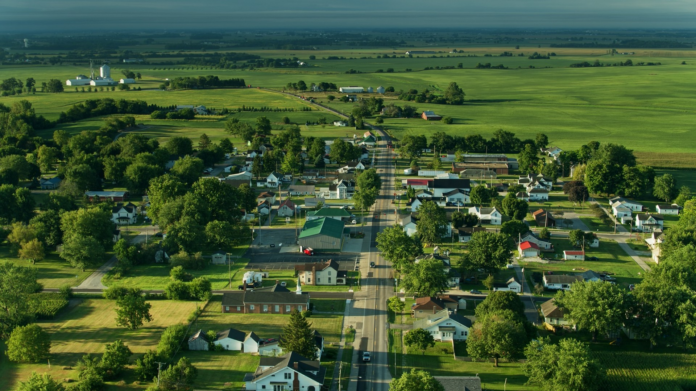Above: “This view of Mount Sterling, Ohio, and surrounding farmland provide the stereotypical view of rural America. Photo: Getty Images”
“While people often talk about “rural America” as if it describes just one way of living, a new study identified five different types of rural communities in Ohio.
The list includes farming areas that many imagine to be stereotypically rural, but researchers also found communities of the rural poor and booming small towns attracting affluent young adults from nearby cities.
“The line between urban and rural areas is getting blurred and very dynamic,” said Darla Munroe, co-author of the study and professor of geography at The Ohio State University.
The analysis showed communities could be separated into five types, based on similar migration patterns. The first three clusters were all found near metropolitan areas:
Urbanizing rural had the highest gains of new households, receiving mostly high-income and young adults coming from metro suburban areas. “These are mainly small towns that experienced booms when a number of high-income households moved in, creating a new, larger core community,” Munroe said.
Suburban middle-income destinations attracted young people from nearby metro areas. Unlike the urbanizing rural group, they were more spread out over an area, she said. “They are living in these far-flung areas where their school is here, the job is over there, and the shopping is someplace completely different. They do a lot of commuting.”
Rural low-income destinations had the highest gains among low-income and older households. They attracted residents from both the nearby metro areas and other rural areas. “These are people going where they can find jobs and affordable housing,” Munroe said. “These census tracts are isolated from nearby affluent urbanizing areas.”
The remaining two types of communities were farther away from cities:
Stable rural areas typically had small increases in residents moving in and were generally associated with farming or rural industrial corridors.
The stagnating rural areas were clustered in the Appalachian region in the southeastern part of the state. These are often in forested and mining areas with little farming. “This is where rural exodus takes place, with people generally moving to other rural areas to find opportunities,” she said.
Overall, the results showed two related trends, Munroe said. First was the greater variation among rural regions, showing that rural America is no longer a monolith.
But at the same time, each type of rural community was attracting the same kind of people, becoming less diverse.
“We have more different kinds of communities in rural areas, but internally they are becoming more uniform,” she said.
Munroe said one thing to be concerned about is how these trends will impact land use.
“If we care about preservation of agricultural land and forested land, we should be paying attention,” she said.
The gap between rich and poor at the rural level leaves questions about whether some communities have resources to steward the land.
“We need to think about what land and management policies might be needed to preserve agricultural and forested landscapes in the state,” Munroe said.” (Grabmeier 2022)
I see wealth disparity discussed a lot within city contexts, so it’s interesting to see that disparity is increasing in rural areas as well. Rural American life is “no longer a monolith” because it is regionally diversifying, but also because issues such as wealth disparity are now experienced by all Americans, whether rural, city, or in between (Grabmeier 2022).
The rural low-income destinations category stands out to me; if people are moving to lower income rural areas in search of affordable housing, does this mean gentrification can occur in rural communities? I’ve only seen gentrification discussed in city suburban contexts.
I’d be interested to see the differences in how the preservation of land is approached in lower income rural areas versus higher income rural areas. Does more money mean more preservation? Or are higher income rural communities unconcerned with land preservation?
Lastly, I’m curious if state parks are noticing any changes in the demographics of their visitors and local residents. And if there are significant changes, does this make it easier or more difficult to implement sustainability initiatives?
Grabmeier, J. (2022, January 13). There’s no longer one rural America – could there be five? There’s No Longer One Rural America – Could There Be Five?; Ohio State News. https://news.osu.edu/theres-no-longer-one-rural-america–could-there-be-five/




